Norwich
|
The capital of East Anglia has much to offer, including a wealth of historic buildings, fine shopping and modern architecture. |
|
An Introduction to the city of Norwich
|
 Norwich
Norwich is considered the capital of East Anglia and has much to offer the visitor. Norwich city centre has streets that still carry a lot of their medieval charm, including some remains of the ancient city walls and a wealth of historic buildings. The Norman Cathedral is one of the finest in England, with its magnificent Cloisters and Cathedral Close. The majestic Castle with its fine 12th century keep is prominently situated overlooking the city. All this contrasts with the modern including the state-of-the-art Forum, Riverside development, and the city's two shopping malls. This is all linked together with some of the most attractive streets in the country including many cobbled streets, alleys and lanes. Norwich also has some fine open spaces, including the wonderful Riverside walk and Chapelfield gardens. Norwich Shops offer one of the top shopping destinations in the UK and has a mix of both high street names and individual boutiques, as well as the largest permanent open air market in England. The city has a wide selection of hotels and its main attractions lie in close proximity to one another and this makes Norwich an ideal city break, as it is easy to explore on foot. |
|
|
|
Click the edges to re-centre the map |
Map contains Ordnance Survey Data © Crown copyright and database right 2014 |
| |
|
Norwich Guided Picture Tour
|
We start our tour of the city of Norwich on a nearby vantage point where the view of the city skyline is simply amazing! From this point you can see the city's main buildings, including the Cathedral, Castle, City Hall and many ancient Churches. You may also be surprised to learn that Norwich city centre is one of the hilliest in England! |
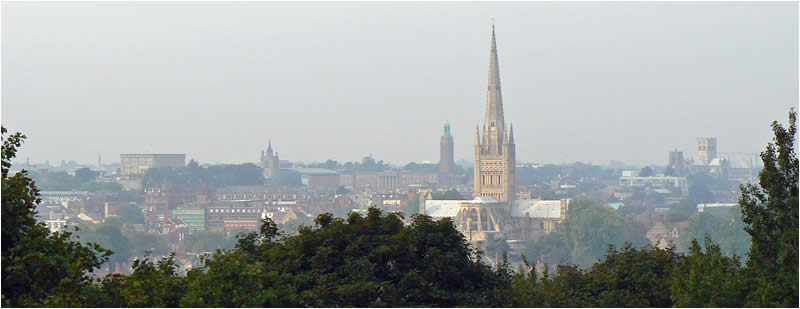 Norwich City Centre Skyline Norwich City Centre Skyline |
Norwich Cathedral dominates the skyline of the city.
The building was started in 1096 and took nearly 200 years to complete, with stone shipped from Caen in Normandy. The cathedral boasts the second tallest spire and second largest medieval cloisters in England. It also has the largest collection of decorative roof bosses in England and is the only church in the Northern Hemisphere to have its Saxon Bishop's Throne in its original position. It remains a place of worship, where one can seek solace and comfort. It is attended by the pupils of Norwich School, who use the cathedral for their daily assembly. It is also the venue for many lectures, concerts and exhibitions. |
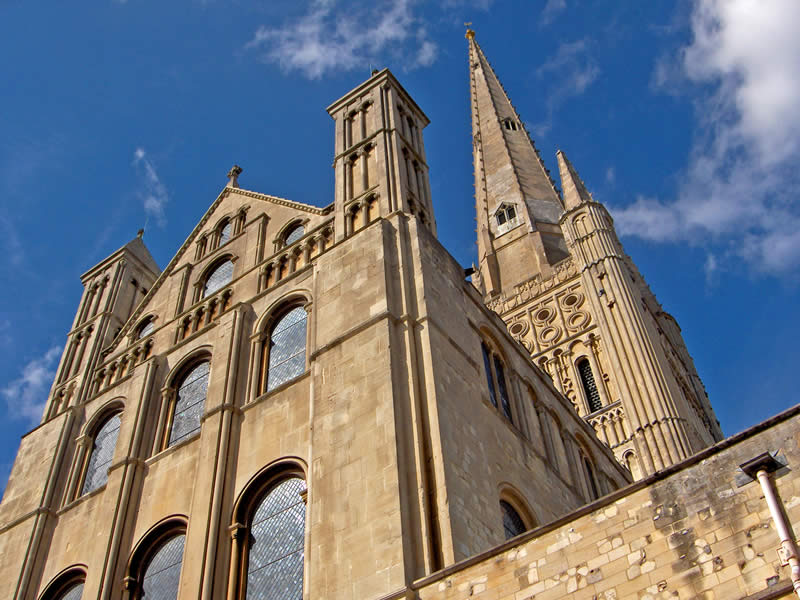
Norwich Cathedral |
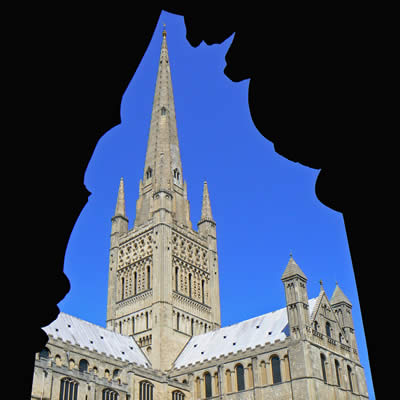
Norwich Cathedral as seen from the Cloisters |
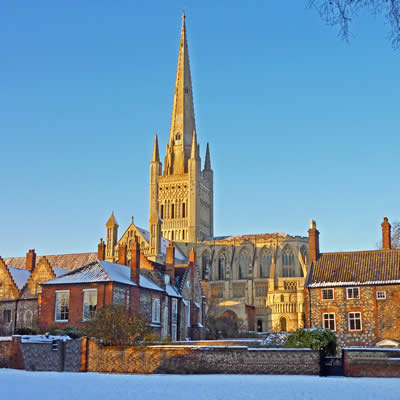
Norwich Cathedral glowing in the winter sunshine |
In 1272 there was a riot by the citizens of Norwich, who had grown increasingly hostile towards the cathedral, irritated by its constant legal and fiscal pressures. Damage was done to the monastery and cathedral cloisters and fires ravaged the building. It has been described as one of the most violent attacks on a religious house to occur in medieval England. This act of violence was not well received and the citizens were forced to rebuild that which they had destroyed! |
Two magnificent gateways lead to Norwich Cathedral from Tombland. Erpingham Gate (c1420) was built by Sir Thomas Erpingham, who led the English archers at the Battle of Agincourt. The second is Ethelbert Gate (c1316) and built by the citizens as a penance after their riot had burnt down the original wooden gate. |
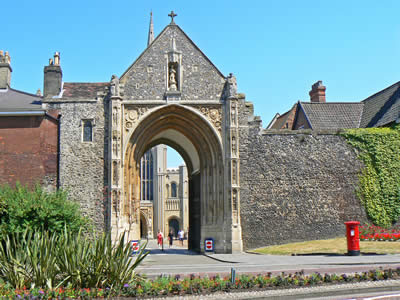
Norwich Cathedral Erpingham Gate |
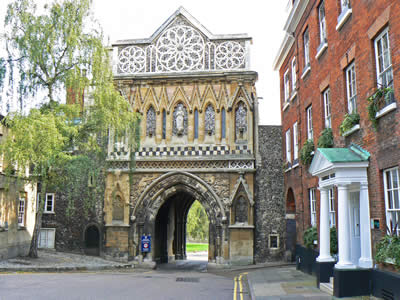
Norwich Cathedral Ethelbert Gate |
Norwich Cathedral is simply magnificent and if you have never explored this wonderful building, you should make time during your visit to Norwich. There is so much to see including detailed stonework, beautiful stained glass, carved wood and all this set in a wonderful atmosphere of tranquility and peace. Norwich Cathedral Close is one of the largest in England and is a very tranquil place. It contains the Prior’s Hall and the Bishop’s Palace and many of the buildings form part of King Edward VI School, which is also known as Norwich School. |
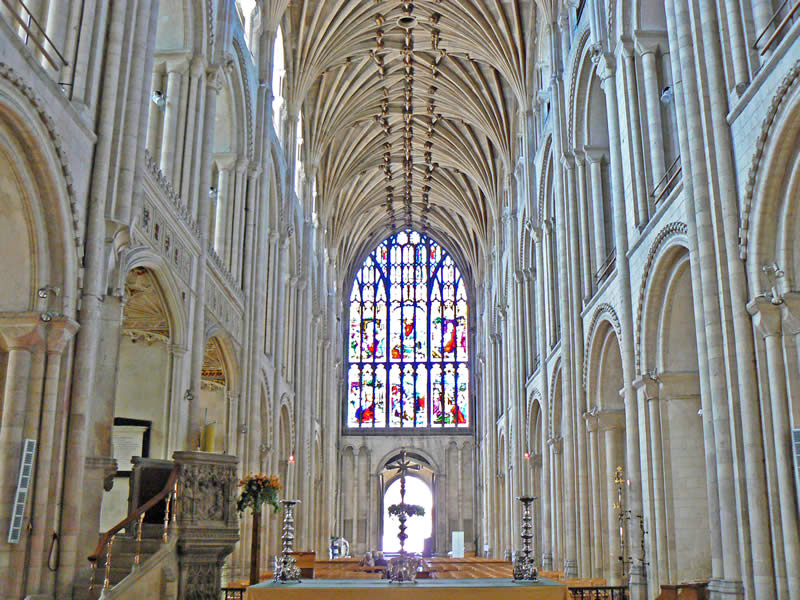
Inside the Nave of Norwich Cathedral |
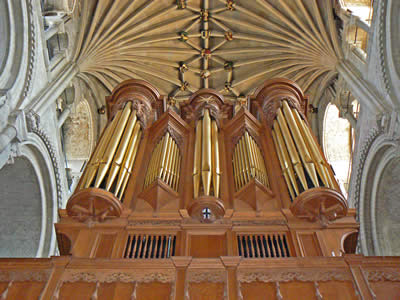
Norwich Cathedral Organ |
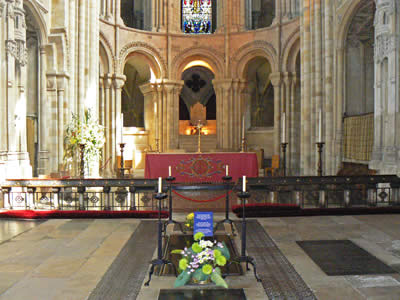
Norwich Cathedral Presbytery |
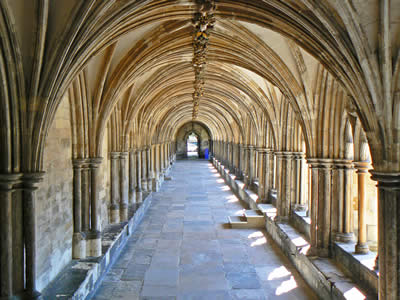
Norwich Cathedral Cloisters |
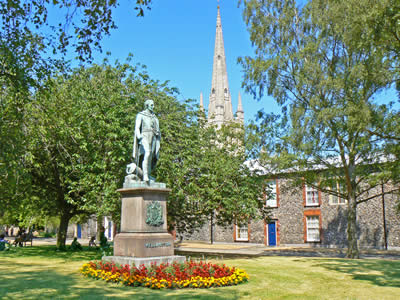
The statue of Wellington in Norwich Cathedral Close |
Norwich also has a fine Roman Catholic Cathedral - one of a handful of UK city's to have 2 cathedrals. Norwich’s Catholic Cathedral was the vision of Henry Fitzalan Howard, the 15th Duke of Norfolk and it provided a new centre of worship for the Catholic community in Norwich. It is the second largest Catholic cathedral in the country, with construction starting in 1882. The nave has ten bays supported by considerable columns and is adorned with marble and fossilised limestone. Other features of significance include a glorious wooden and painted rood, shrines and carvings, magnificent Victorian stained glass windows and stone gargoyles. |
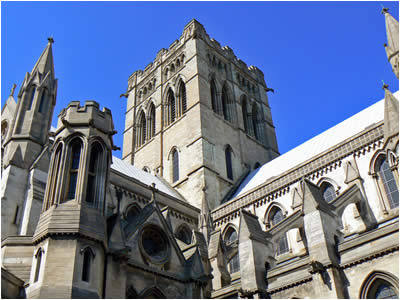
Norwich Roman Catholic Cathedral |
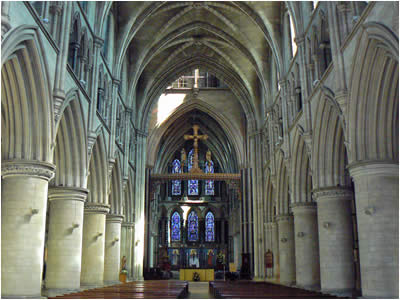
Inside Norwich Catholic Cathedral |
Norwich has plenty of other ancient churches.
In medieval times there were 57 churches inside the city walls, and 31 still exist today - which is one of the greatest concentrations in the whole of England. Most are skillfully built in local flint. |
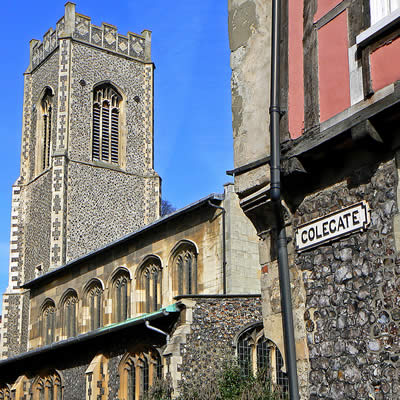
St George, a medieval church in Colegate |
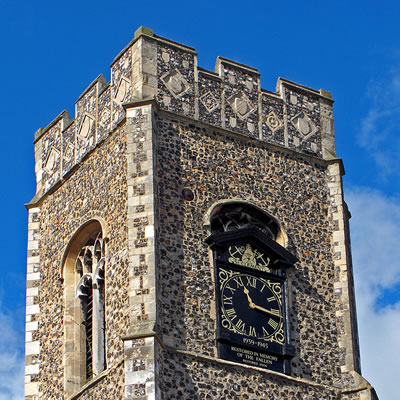
Norwich Church - St. Clements |
RIVERSIDE WALK - 2 miles approximately (including from the city centre)
|
The Cathedral Close leads us to the Riverside Walk, a
picturesque walk along the bank of the River Wensum. It makes a complete change from the city centre and with a few pubs along the way, it's a great thing to do on a sunny day. The River Wensum flows through the city and links Norwich with the Norfolk Broads. For 800 years, the River Wensum was the lifeblood of the city and carried all kinds of goods to and from Norwich; the goods were carried in flat sailing barges, called wherries. |
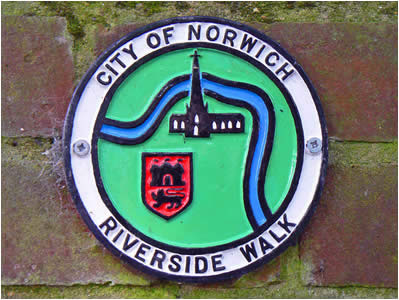
Norwich Riverside Walk |
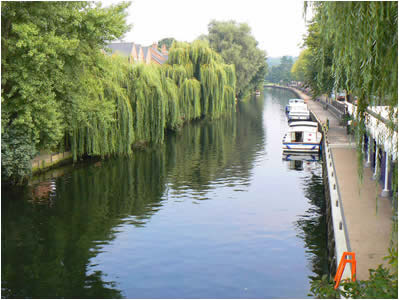
Norwich Yacht Station |
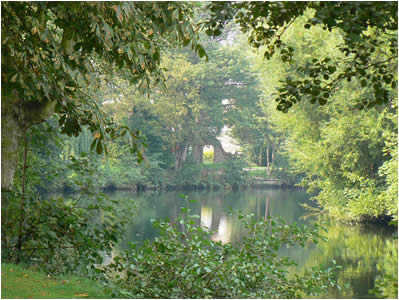
Norwich River Wensum Walk |
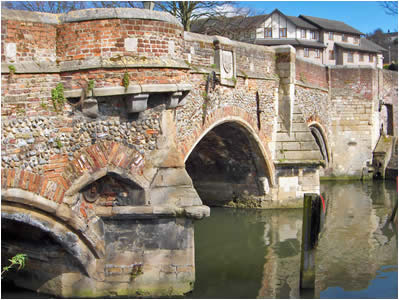
Norwich Bishop Bridge |
 |
Two interesting buildings you will come across on the Riverside walk.
|
Pulls Ferry is a 15th century arch, named after a ferryman who worked here. It marks the start of an ancient canal to the cathedral; used to ferry stone as close to the construction site as possible. |
|
Further along the riverside path is a medieval brick defensive lookout called Cow Tower. It was built at the end of the 12th Century at a strategic bend in the River Wensum as part of the city defences. |
|
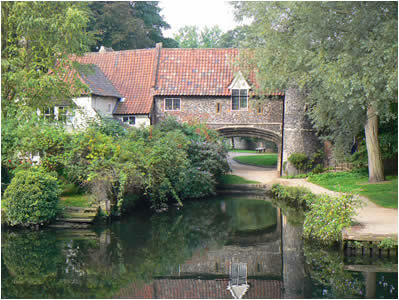
Norwich Pulls Ferry |
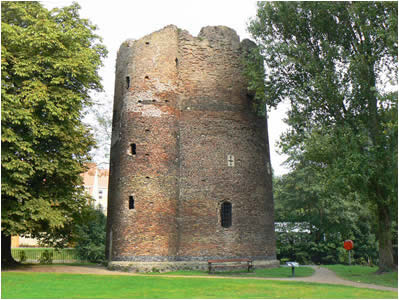
Norwich Cow Tower |
Just off the Riverside Walk is the haunted Adam and Eve Pub, believed to be the oldest public house in Norwich. Records of its existence date back to 1249, when workmen rebuilding parts of the Cathedral came to the inn to be paid for their labours in bread and beer. The bar retains many original features; there has been little structural alteration in the last 750 years. It is haunted by the ghost of Lord Sheffield, killed here in 1549! |
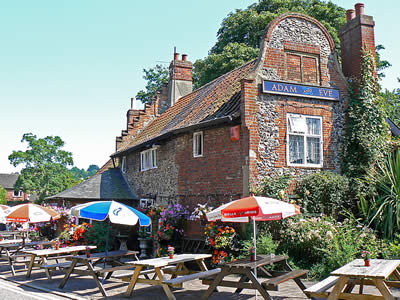
Norwich Adam and Eve Pub |
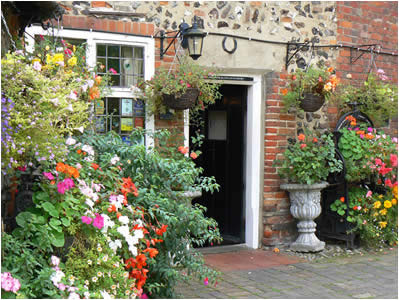
Norwich Adam and Eve Pub |
Adjacent to the cathedral is Tombland (meaning " open space") which was the site of the Anglo-Saxon Market before the Normans arrived and changed this area of the city. Some of the old buildings have survived, including Augustine Steward's House, built in 1530, now home to a collection of antique dealers. Tombland today also consists of little alleys,
quality restaurants and bars. |
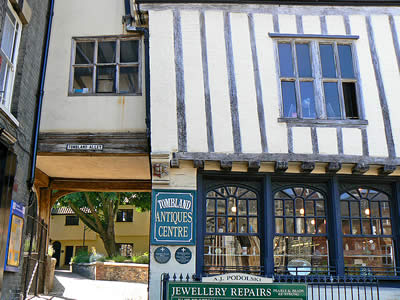
Norwich Tombland Alley and Antiques |
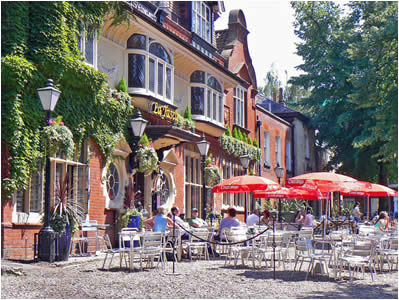
Norwich Tombland Restaurant |
Standing in the shadow of the Cathedral for nearly 900 years, Tombland has seen skirmishes, rebellions, and battles; it has also seen the horrors of various plagues and the persecution of many religious believers. It is not surprising therefore, to learn that Tombland is one of the most haunted parts of Norwich. |
From Tombland we rise up an impressive cobbled street called Elm Hill, one of the oldest streets in Norwich and is a leap back in history. It was largely rebuilt after the great fire of 1507 but still retains its Tudor character to the present day. The narrow cobbled streets are flanked either side by genuine Tudor houses some of which are now pretty little shops. One interesting fact is that there are more Tudor houses in Elm Hill than in the whole of the City of London. |
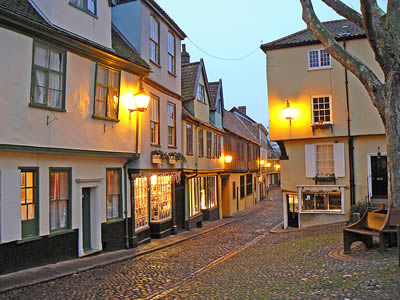
Norwich Elm Hill |
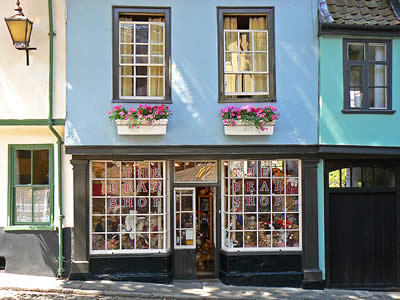
The Bear Shop, Elm Hill, Norwich |
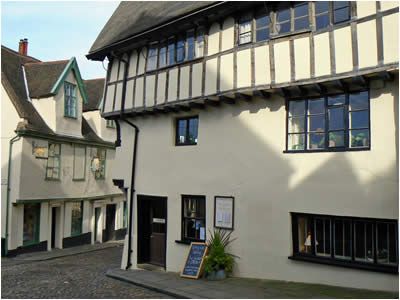
Norwich Cobbled Streets |
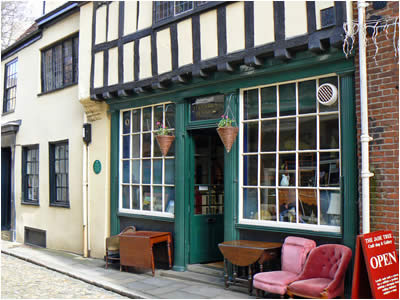
Pettus House on Elm Hill |
The Museum of Norwich at the Bridewell showcases Norwich life and industry. The building was a former merchant's house dating from 1325 and then a prison for tramps and women (a bridewell). You can see displays covering the Norwich food industry, iron foundries and examples of early fire appliances.
The museum is home to a fine collection of old shoes, all manufactured in Norwich. There is also a recreation of a 1930's pharmacy, one of the most complete examples in the country. |
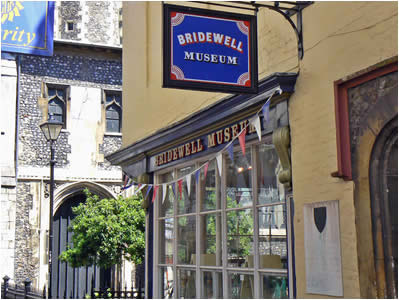
Museum of Norwich at the Bridewell |
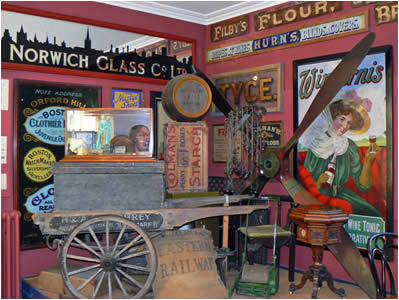
Norwich Bridewell Museum - Norwich Industry |
At nearby Strangers Hall, one of the oldest buildings in Norwich, there is a museum of English domestic life. The house is set out as a series of rooms, showing how people lived from Tudor to Victorian times. There is a warren of passages, staircases and interlinked rooms, including several dining rooms, a music room and a room made completely from paper! |
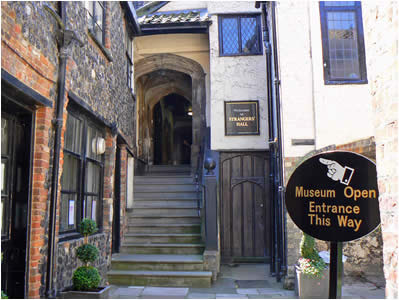
Norwich Strangers Hall Museum |
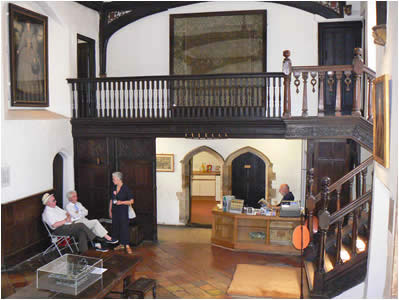
The Great Hall |
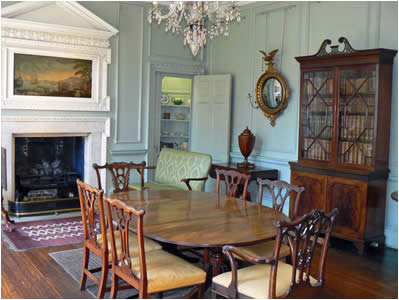
Norwich Strangers Hall - Edwardian Dining Room |
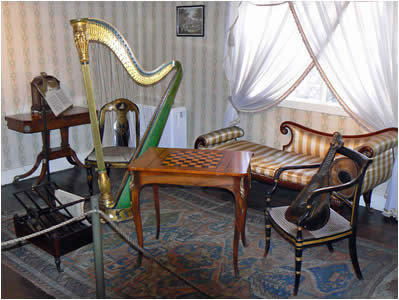
Norwich Strangers Hall - Regency Music Room |
Norwich is one of the top shopping destinations on the UK, with a mix of small individual boutiques and large high street stores. You will find two modern shopping malls, one of the largest outdoor markets in England and many picturesque lanes, alleys and streets.   See our special guided tour of Shopping in Norwich. |
| |
The first shopping area we come across is an area called the Norwich Lanes. Situated along narrow cobbled streets are some lovely small individual shops, bars and restaurants. |
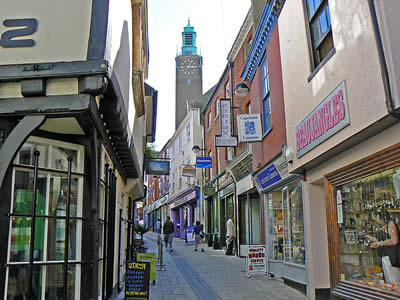
Norwich Lanes and Shops |
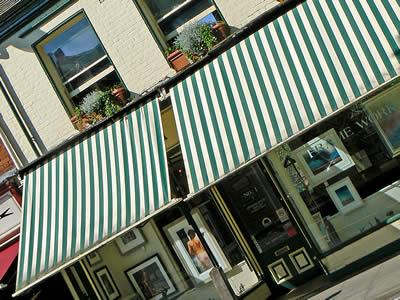
Art Gallery along the Norwich Lanes |
Jarrolds store is widely regarded as the flagship independent Store in Norwich and twice winner of the UK's Independent Department Store of the Year. A family run Department Store at the heart of Norwich since 1823, Jarrolds offer a unique and contemporary shopping experience, with a sense of heritage. As well as the independent stores, Norwich also contains the usual well known high street names! |
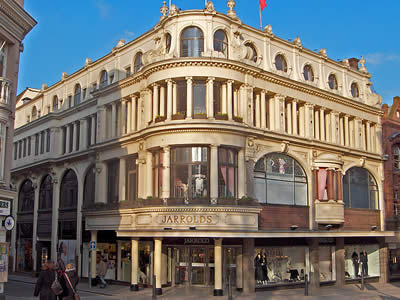
Jarrold the store, London Street |
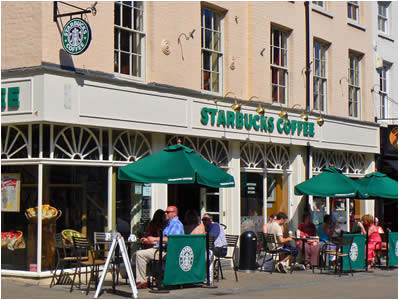
Norwich Starbucks Coffee |
After the Norman Conquest of 1066, the market was moved here, in an area known as ' Mancroft', to give it more space. By 1300 the market had grown substantially and sold vegetables, fish, meat, bread, cloth, shoes, rope, livestock and many other commodities; all from their own designated place. Today, Norwich Market remains one of England's largest and finest open air markets. The market is open Monday to Saturday, with around 200 traditional stalls covered with a canopy of stripped canvas. |
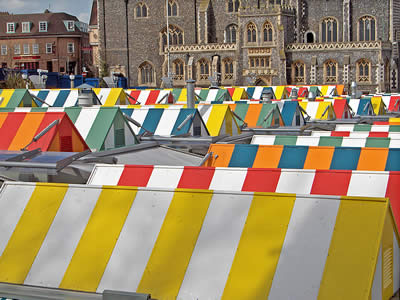
Norwich Market |
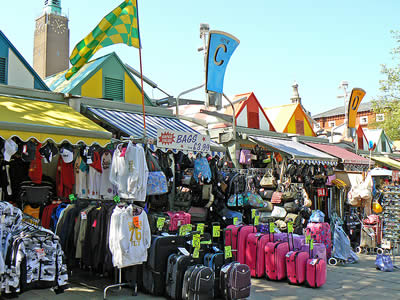
Stalls on Norwich Market |
Situated above Norwich Market place, Norwich Guildhall replaced the long-standing toll-house; a small thatched building used for collecting the toll from the market, and dating from the 13th century. The Guildhall was used for both civic and judicial functions for some five hundred years. The very distinctive design of fine chequered flint work on the outside shows the city was amongst the largest and wealthiest city's in England. Today, it has a lovely cafe situated inside the old court room. |
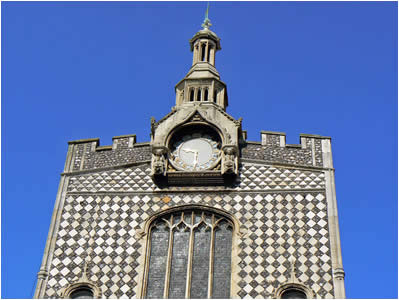
Norwich Guildhall |
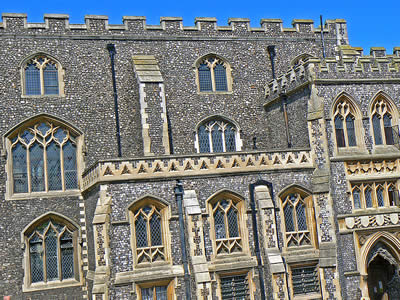
Detailed flintwork on Norwich Guildhall |
| |
Norwich City Hall was built as a response to a growth in local government duties; the Guildhall had become cramped and unworkable. The building was opened in 1938 by King George VI to the largest gathering of citizens the city had ever seen.
The hall has an art deco interior and boasts a wealth of artistic details, clearly shown with the heraldic lions outside the building. City Hall holds the largest clock bell in the UK, with the deepest tone in East Anglia. It is also home to the longest balcony in England, at 365 ft long. |
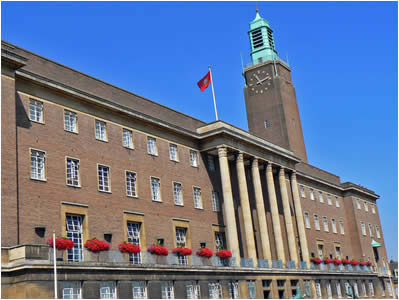
Norwich City Hall |
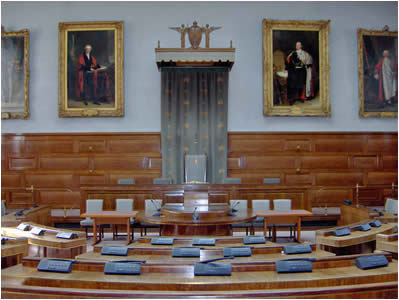
Norwich Council Chamber |
Nearby is the ultra modern Forum, a landmark Millennium project for the East of England and is on the site of the former Central Library which was destroyed by fire in 1994. This £65 million project was funded by a £31 million grant from the Millennium Commission. The Forum houses a state-of-the-art public library and the American 2nd Air Division memorial library). The Forum is also home to BBC Look East and Radio Norfolk, as well as offering a library, coffee shop, pizza restaurant and tourist information. |
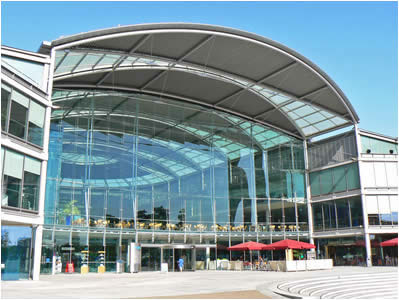
Norwich Forum |
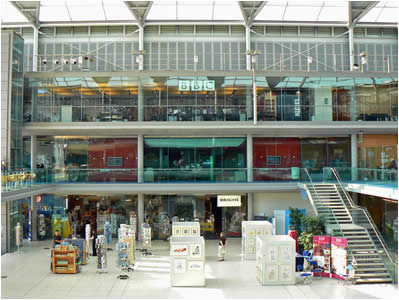
Norwich Forum - BBC Look East, Radio Norfolk |
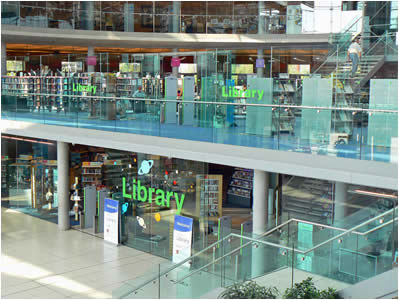
Norwich Forum Library |
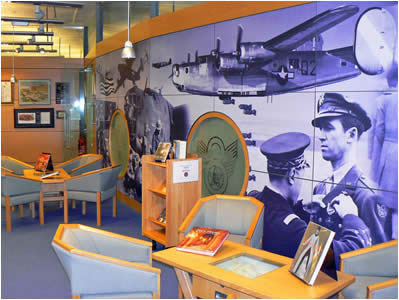
Norwich Forum - USAAF Memorial Library |
Sandwiched between the Forum and Market is the church of St Peter Mancroft. This is the largest church in Norwich and is often mistaken for the Cathedral by some visitors! It dates from the mid-15th century and has some fabulous features, such as its organ, font, alter and treasure room, containing ancient artifacts including stained glass, cups and bowls. |
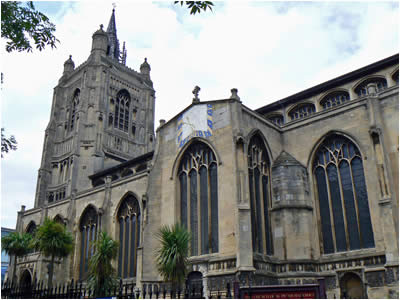
Norwich St. Peters Mancroft |
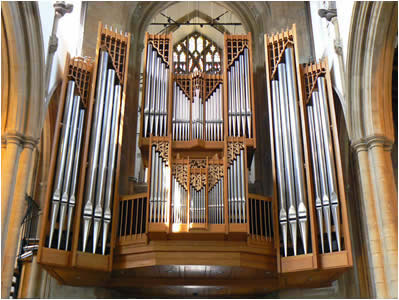
The magnificent Organ inside St. Peters Mancroft |
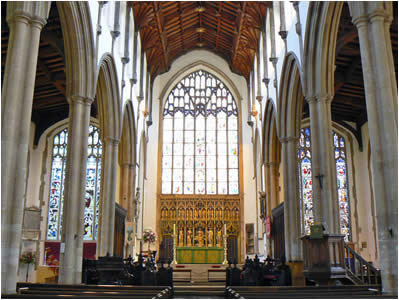
Inside St. Peters Church in Norwich |
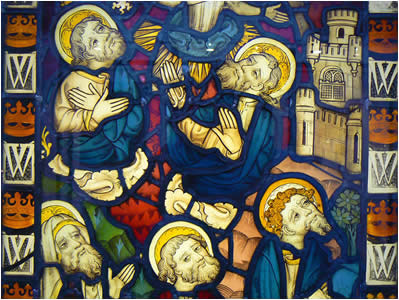
Beautiful stained glass in St. Peters Treasury |
Norwich Royal Arcade runs from the market place towards Norwich Castle and was designed by architect George Skipper in 1899. It has been described as a fragment of the Arabian Nights dropped into the heart of the old city!
Among its many interesting features are some specially designed glazed tiles manufactured by Doulton, with images of Peacocks and flowers. Today the Royal Arcade contains a row of fine timber fronted shops. |
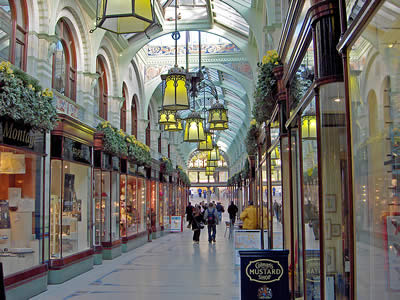
Norwich Royal Arcade - Coleman's Mustard Shop |
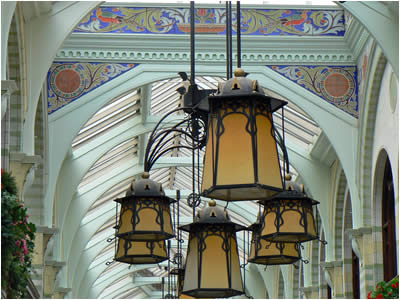
Norwich Royal Arcade |
One of the most famous Norwich landmarks, Norwich Castle was built by the Normans as a Royal Palace 900 years ago. Used as a prison from the 14th century, the Castle became a museum in 1894.
One of Norfolk's principal museums, the Castle is packed with treasures including outstanding collections of fine art, archaeology and natural history - some exhibits are of national importance including the world's largest collection of ceramic teapots. |
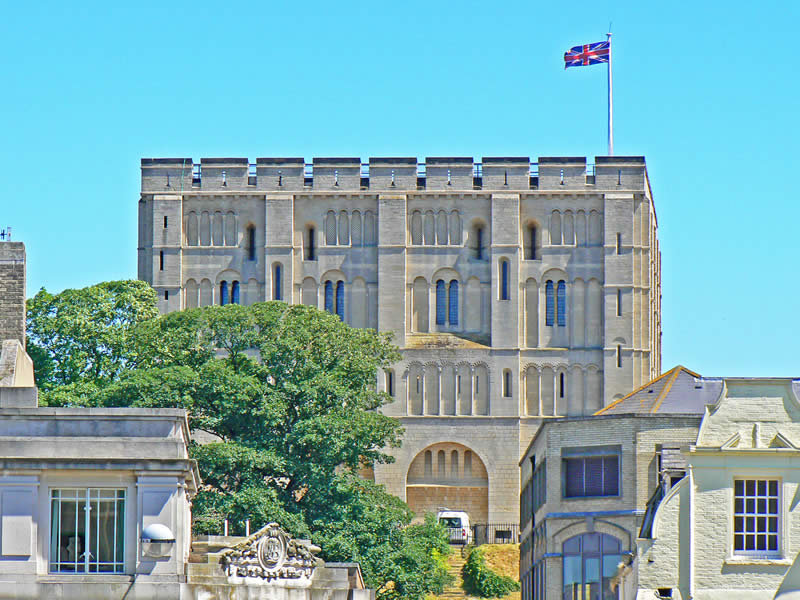
Norwich Castle overlooking the fine city of Norwich for around 900 years |
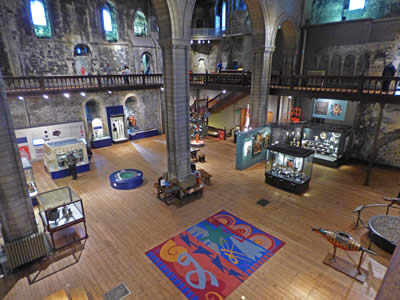
Inside the Keep of Norwich Castle |
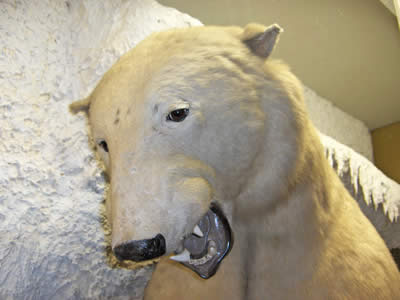
Norwich Castle Natural History Museum |
Norwich Castle was used for many executions, but the most famous was of Robert Kett in 1549. Kett led an army of 20,000 rebels complaining about unfair enclosures of common land by corrupt landowners. Kett laid siege to the City of Norwich in July 1549, but was eventually captured, and tried in London. He was brought back to Norwich where he was executed by hanging from the castle – his body was left to rot as a warning to others. |
Underneath Norwich Castle is the Castle Mall shopping centre, opened in 1993 the site redeveloped one of the oldest streets in Norwich (Timberhill) as well replacing the unsightly area of the old cattle market. The Castle Mall features a vast array of shops on three levels, food courts, two car parks, bars and restaurants, a cinema and even park gardens on the top. |
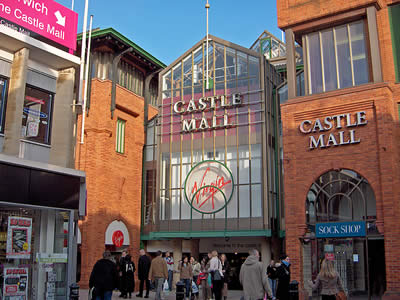
Norwich Castle Mall |
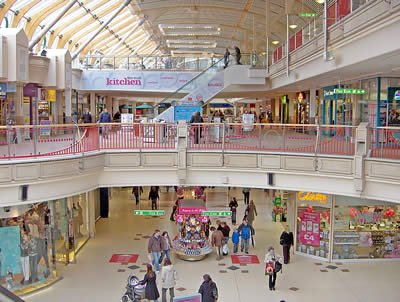
Norwich Castle Mall Shops |
| |
The other shopping mall in Norwich is Chapelfield (known as Chantry Place) this shopping mall has over 80 shops, plus cafés and restaurants. The £275m centre was built on a former Nestle factory site and opened in 2005. |
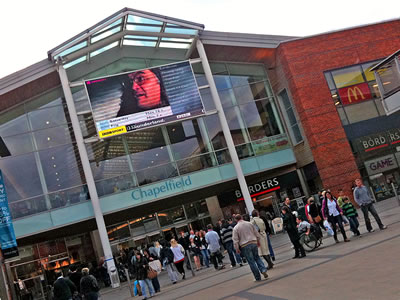
Norwich Chantry Place (Chapelfield) |
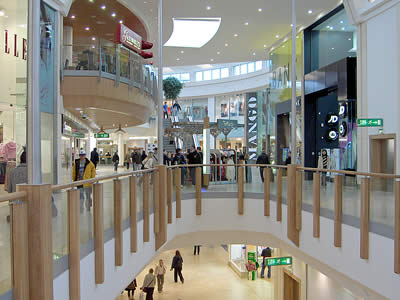
Norwich Chantry Place Shops |
| |
Close to the shopping mall is Chapelfield Gardens, which date back to the 13th century, when the grounds were part of a hospital and chapel. In 1944, Glenn Miller gave a concert in the Victorian bandstand! |
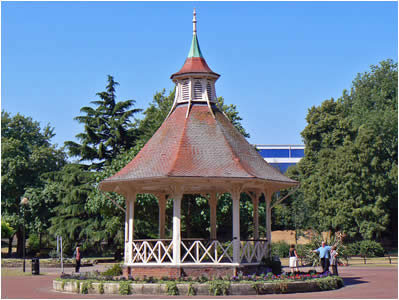
Norwich Chapelfield Gardens |
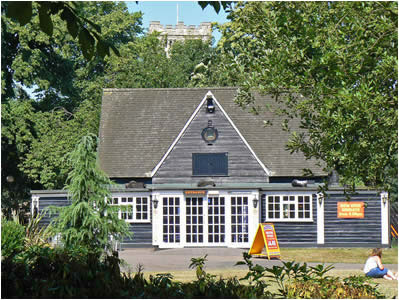
Norwich Chapelfield Gardens |
Chapelfield Gardens is traditionally where the locals were taught to fight. Back in the 15th century archers used the field (now Chapelfield Gardens) to train before the battle of Agincourt. In 1580 the Yeomanry (mounted volunteers) were trained to resist invasion by the Spanish Armada. |
Norwich Assembly House is a lovely Georgian house, built in 1754 as public rooms. Inside the building you will find many beautiful rooms that are used as public meeting rooms and venues for events; there is also a restaurant. |
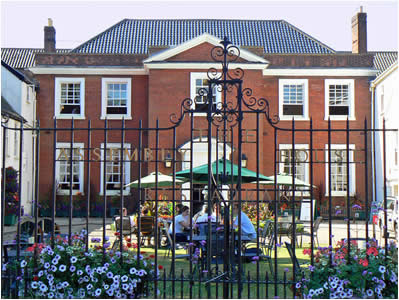
Norwich Assembly House and Restaurant |
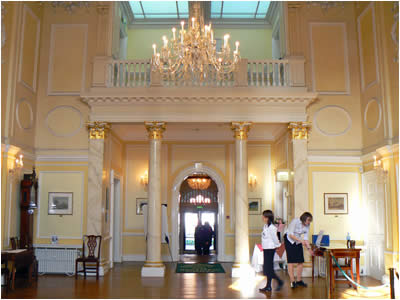
Inside the Georgian Assembly House |
Norwich is a city of culture, with several theatres, performing venues and an annual festival in early May ( Norfolk and Norwich Festival). Norwich Theatre Royal is East Anglia's premier theatre and dates back to 1758, but the current building dates from 1826. The theatre stages a regular programme of comedy, drama, musicals, dance, opera, music and family shows. Norwich Playhouse is a welcoming theatre showing contemporary drama and dance, great jazz and the best in stand up comedy. The Maddermarket Theatre stages a year long programme by top British and World playwrights, professionally created and staged by members from across the region. Finally, but by no means least, the Norwich Puppet Theatre is a unique venue dedicated to puppetry and host to the Norwich Puppet Theatre Company, which presents a full and exciting programme of plays and workshops to entertain and enthrall. |
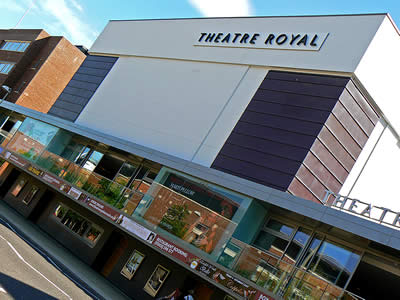
Norwich Theatre Royal |
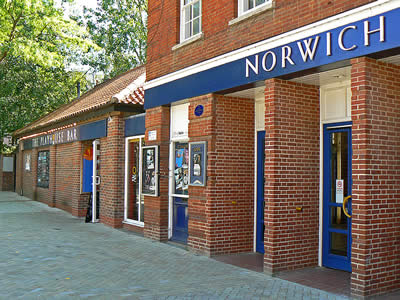
Norwich Playhouse |
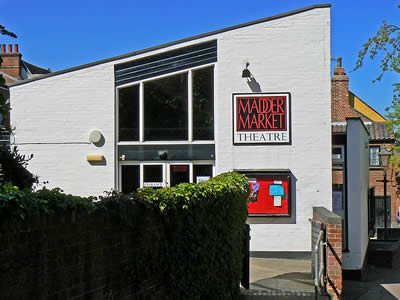
Norwich Maddermarket Theatre |
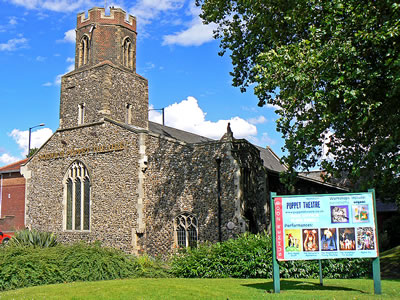
Norwich Puppet Theatre |
Probably the most famous Norwich business is Norwich Union (now Aviva). Founded in 1797
by Thomas Bignold, a wine merchant and banker who moved from Kent to Norwich. In
1905
Surrey House, the Life Society's new purpose-built head office designed by George Skipper, opened in Norwich. The main hall was decked out in marble that had originally been destined for Westminster Cathedral.
The famous Norwich Union clock was put up in 1927. |
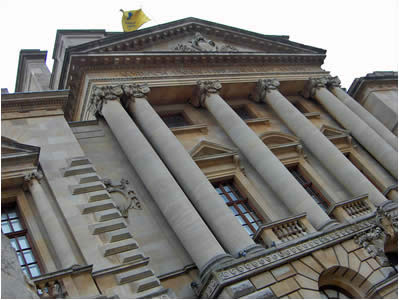
Norwich Union Surrey House |
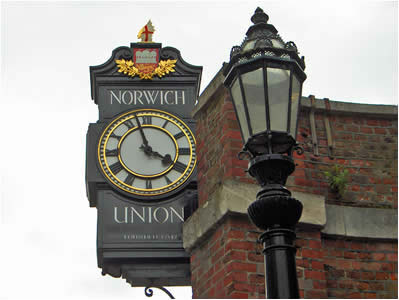
Norwich Union Clock |
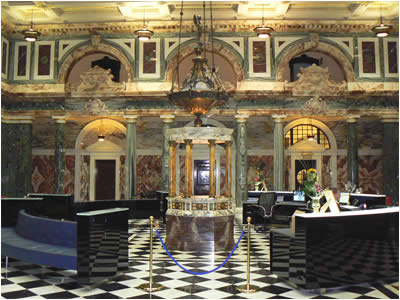
Inside Marble Hall |
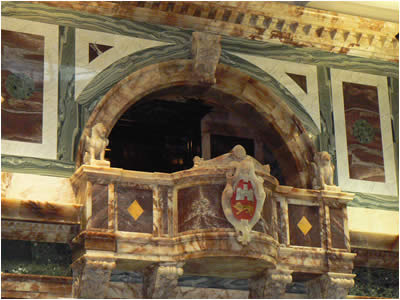
Marble Balcony in Surrey House |
One hidden gem is Dragon Hall, partly because its a little way out of the city centre, but a new footbridge over the river now connects it with the Riverside leisure complex (see below). Dragon Hall is the only surviving medieval trading hall in Western Europe, built by an individual. It was built with close studded timber framing and contained a grand hall. The ground floor rooms and the undercroft were used as storage for goods. One of the spandrels (triangles of space between the beams and braces) was intricately carved with a figure of a dragon – it is from this that the hall took its name. Today, there is a new north wing on Dragon Hall, and, on the rear of the building, a glass gallery. |
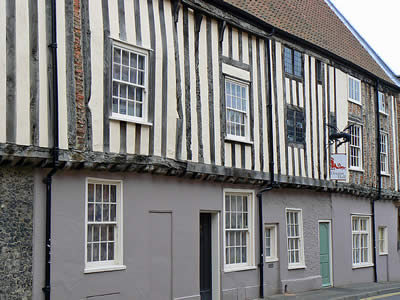
Dragon Hall |
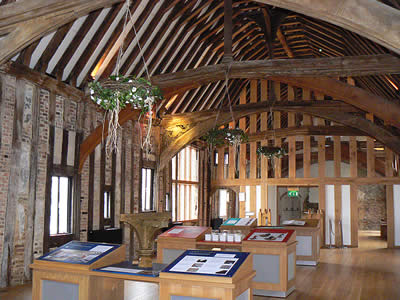
The Great Hall containing a carved Dragon spandrel |
Locals say Norwich once had an inn for every day of the year and a church for every Sunday. Nowadays there are still many delightful inns, but the number today is nearer 150 rather than 365. However, there is still a huge variety catering for all tastes. You will find a host of traditional and charming real ale pubs, classy wine bars and popular chain pubs throughout the city.
|
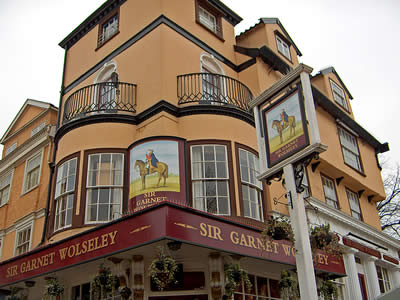
Norwich Pub - Sir Garnet Wolseley |
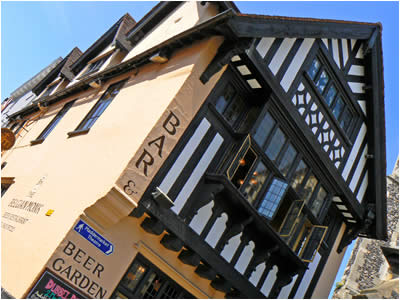
Belgian Monk Bar |
Norwich Station was built in 1836 as the terminus of the Great Eastern Railway. The building was given a fine façade, in a French Chateau style. The River Wensum separates Norwich station from the Compleat Angler pub - the first stop after arrival. |
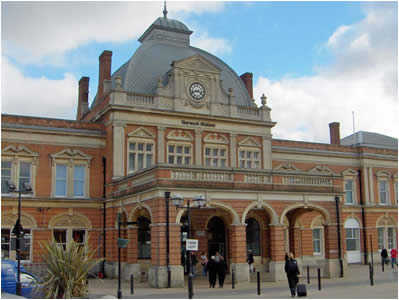
Norwich Railway Station |
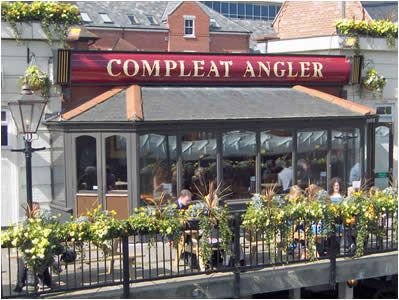
Norwich Riverside Pub - Compleat Angler |
Finally, Norwich Riverside Leisure Complex (next to the station) is a new complex of restaurants, bars, cinema and bowling alley - this area is really good for your night out! |
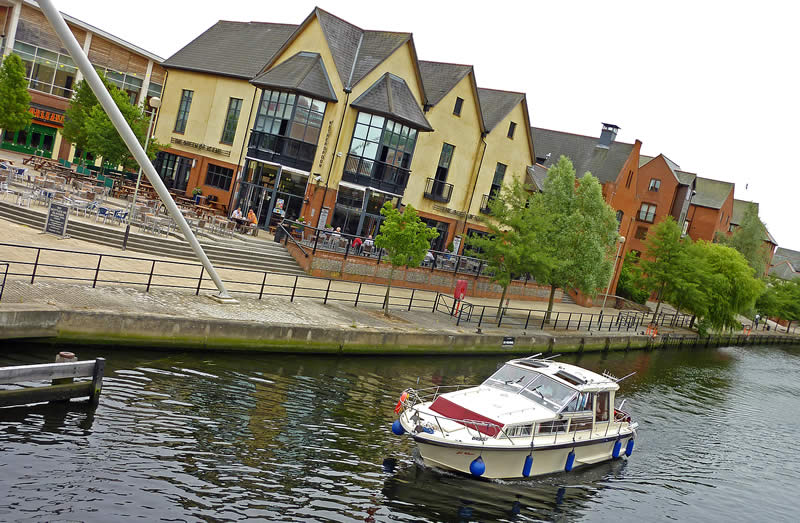
Old Orleans Restaurant, Norwich |
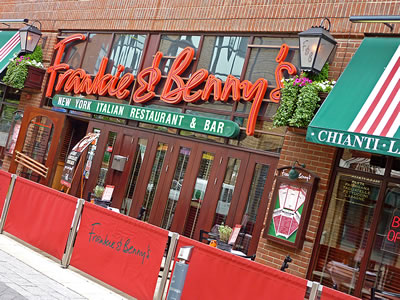
Frankie & Benny's Restaurant, Riverside Norwich |
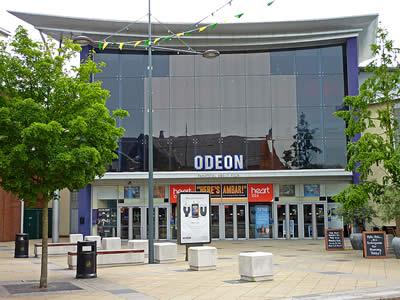
Norwich Odeon Cinema |
You may also like to visit nearby Whitlingham Country Park, just southeast outside Norwich at Trowse and is a great place to walk, cycle, picnic or birdwatch. You can get to the park on the river bus from central Norwich. |
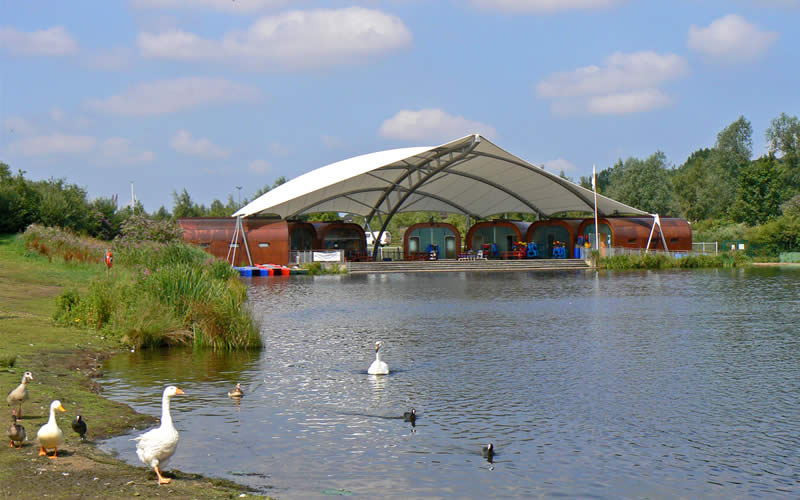
Norwich Whitlingham Country Park |
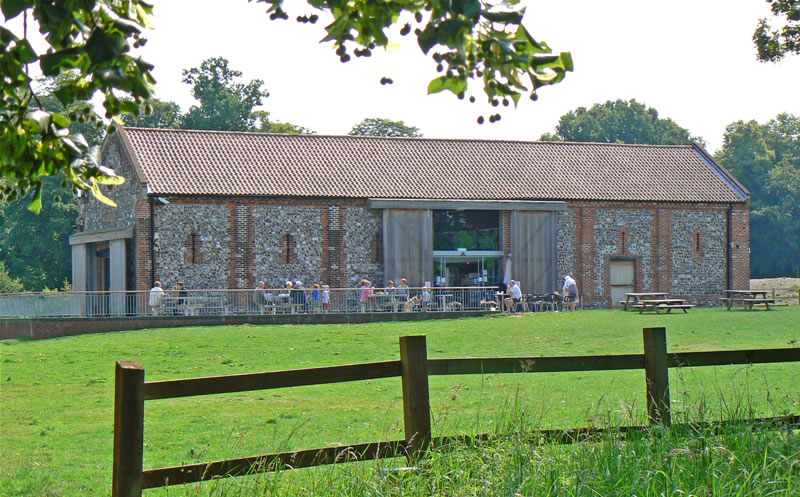
Whitlingham Country Park |
Norwich Summary of What to SEE and DO
|
 Visit the city's Cathedral's - don't forget Norwich has two of them! |
 Take a look around Norwich Castle and museum |
 Take a walk around the cobbled lanes and alleys - don't miss Elm Hill |
 Shop till you drop in the centre, market and 2 malls - Chapelfield and Castle Mall |
 Walk along the riverside and find Pull's Ferry and Cow Tower |
 Visit the medieval Guildhall or modern Forum |
 Learn the history of Norwich on a walking or bus tour |
 Visit the Bridewell Museum or Strangers Hall |
 Enjoy a boat trip along the River Wensum |
 Relax in a city centre bar or restaurant |
 Enjoy a night out at the theatre or taking in a movie |
 Sample a drink or a full meal in the city's many bars and restaurants |
|
Our Verdict |
Norwich is up there with the very best of the heritage city's in Britain. There are plenty of historic buildings and streets, that are given a modern twist with a state-of-the-art media centre and its 2 shopping malls. A great place for a weekend city break or day-trip. |
Readers Comments |
The pictures are absolutely beautiful. I spent 3 years at RAF Lakenheath, which consisted of going to Norwich twice a week. Its such a beautiful city. Some of the pictures I remember though just a vague memory. I left me heart there and always wanted to return. It was in the early sixties and I used to go to the American Club. Thanks for the memories, Dominick, USA. |
| |
Have just spent an hour or two just browsing through Norwich, some places have changed but others are still the same as when a young lad on a school journey in the early 1930s. A wonderful site, congratulations on bringing back many memories of many years ago. I have lived in Australia for 52 years now. Thank you. |
| |
Absolutely brilliant, I love Norwich and just looking at this site makes me feel like I am there. A marvelous guide for visitors, I haven't seen any better for any other city. Regards Linda. |
|
|
TOUR INDEX |
|
|
|
|
|
|
|
|
|
|
|
|
|
|
|
|
|
|
|
|
NEARBY PICTURE TOURS |
|
|
|
TOURIST ATTRACTIONS |
 |
|
|
|
|
|
|
|
|
MORE OF OUR WEBSITES |
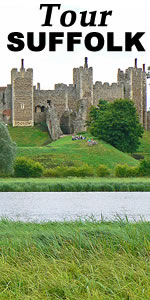 |
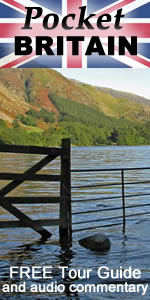 |
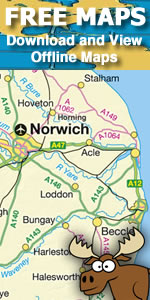 |
| |
|

